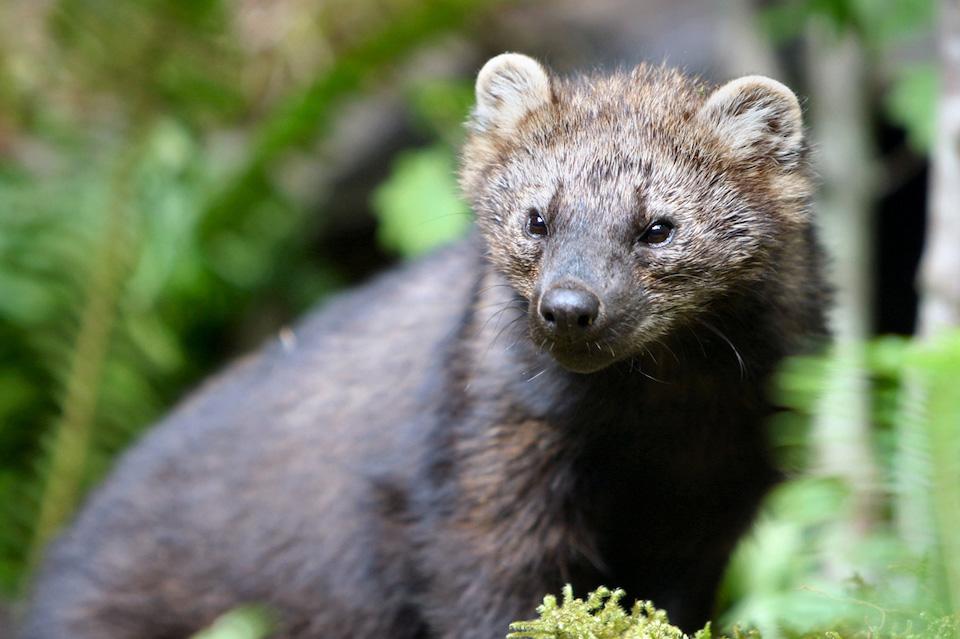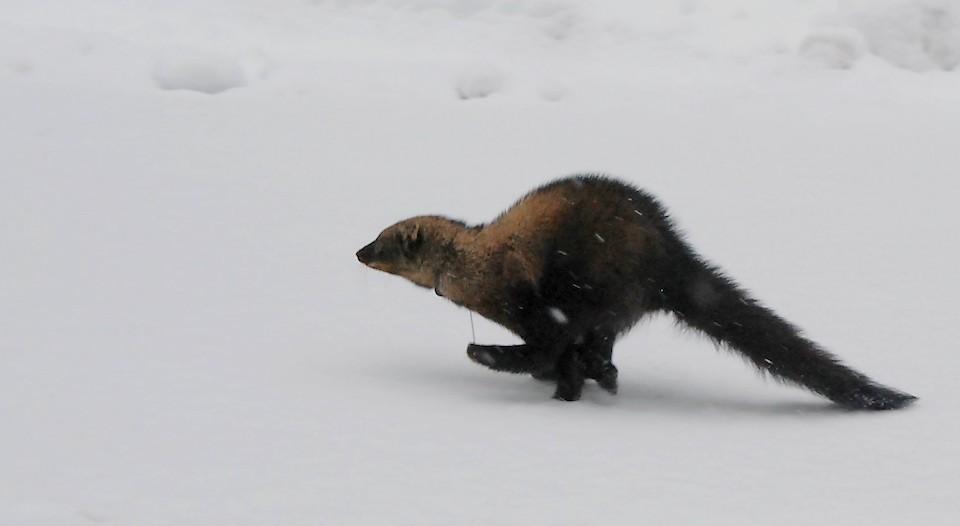
A fisher recovery operation in the Pacific Northwest has been meeting with success/NPS file
Editor's note: The following article documents efforts by by Washington’s National Park Fund to help recover fishers in Olympic, Mount Rainier, and North Cascades national parks.
Fishers (Pekania pennanti) became extinct in Washington State in the early 1900s. This cat-sized carnivore is closely related to the American martin and mink – think rich, silky fur – which is one reason why it was over-hunted. Losing habitat to logging and development also contributed to their declining numbers.
Its name is believed to be related to the word "fitch," meaning a European polecat or the pelt of that animal. It does not actually eat fish but does love a good porcupine! Fishers will circle their prey until it’s confused and dizzy, preventing it from getting into a protected position (facing a tree or rock with tail out). It then attacks and kills it. They also eat mountain beavers, squirrels and snowshoe hares; if they can’t catch a mammal, they’ll eat insects, birds, berries and nuts.
Washington’s National Park Fund has been helping support the release of fishers, first in Olympic National Park in 2008, and then Mount Rainier in 2015. In Olympic, fishers are spreading out from where they were first reintroduced in the park, into national forest areas, managed forests and along the Pacific Coast. Several females have been photographed by remote wildlife cameras carrying kits (babies) from one den location to another.
Starting in 2015, Mount Rainier and North Cascades National Parks worked together on the Cascades Fisher Reintroduction Project. This partnership of federal, state, and non-profit organizations has reintroduced 69 fishers to Mount Rainier, Gifford Pinchot National Forest and the larger south Cascade ecosystem, and monitored them using radio telemetry to determine survival, territory and reproduction. The goal is to release a total of 80 fishers in both the North and South Cascades areas.

Remote cameras captured a female fisher with kits/NPS file
After finding that collared fishers often broke their antennas or slipped the collars, wildlife biologists began to implant a cigar-sized and shaped transmitter into their abdomens – ouch! While it sounds uncomfortable, the fishers don’t seem to be aware of this bodily intrusion. They are then able to be monitored with radio telemetry from the air and from the ground.
In Gifford Pinchot National Forest in 2017, the team reported that a female fisher, code-named F023 (but familiarly called “Lilly”), was likely denning in an area that was not too far to reach by snowmobile. Lilly had started using a very localized area within her home range and, since it was during the denning season, the team was pretty excited to learn if Lilly was taking care of kits. Biologists trekked to her home range to try to find her while she was at her den. They could then set up cameras on the den tree and photograph her coming and going as she cared for kits and left to go hunting.
The first try was unsuccessful as Lilly was merely resting on a snag away from her kits – as any tired parent of multiples would do! On the team’s second try, they found a more likely tree and several cameras were set up to record Lilly’s comings and goings. When the team returned two weeks later, pictures showed Lilly at the tree at various hours of the day and night, strong evidence that she was caring for kits. Then the team really struck gold - a remote camera photographed Lilly coming down the den tree, head-first, carrying one large kit with her! This was another thrilling event for everyone involved.
As of October 2018, researchers had collected 997 locations of fishers in Mount Rainier and surrounding national forest using aerial telemetry. Survival rates are high, and two females have now been photographed with kits.
The reintroduction project in the North Cascades was postponed after fires in British Columbia, in summer 2017, caused the provincial government to rescind trapping permits. The fires (in prime fisher habitat) not only impacted fishers, but also people, homes, property, traplines, forested habitats and other wildlife. The BC Ministry of Forests, Lands, and Natural Resource Operations stopped all fisher trapping in central BC until they could determine how many fishers had survived.
Jason Ransom, wildlife biologist with North Cascades National Park Service Complex, recently updated the partners on the Cascades Fisher Reintroduction Project in the park:
The Washington team was very supportive of the Ministry’s efforts to protect [the BC] fisher population, because this population and the Ministry’s support have been tremendously important for restoring fishers in Washington. Now, the team has begun working with Canadian managers and fur trappers to locate and catch fishers from a new, much more populated, area a little farther east. The hope is that fishers could be arriving and being released in North Cascades National Park and Mt. Baker-Snoqualmie National Forest as early as this November.
Indeed, the North Cascades project has now restarted with fishers obtained from Alberta, Canada. State, federal, and partner biologists released eight fishers in December 2018 in the Skagit River watershed of Ross Lake National Recreation Area. Lummi Nation Blackhawk Singers drummed and sang to wish the first fishers to be released – five females and one male – a good journey, and children watched and cheered. Aerial monitoring began in the North Cascades in December and the releases have continued throughout the winter.
Frank Bob, policy representative for the Lummi Natural Resources Department, said: “It is good to see us finally giving something back. For so long, I've seen things coming out, being taken. But I haven't seen very much put back. This is a big thing. Mother Nature is praising us today."
Operating costs for the new fisher receiving station in Alberta and at the Calgary Zoo are running nearly double what they were for the BC operation, so the park is looking for extra funding to cover these needs for the coming year. Park staff has said, however, that the Alberta partnership is amazing and will get the project through to the finish line.
Previously released fishers at Mount Rainier National Park and Gifford Pinchot National Forest are still being tracked and appear to be doing well. The team will begin looking for dens and kits again this spring as the snowpack melts out. Remember, if you’re out and about in either the Cascades or the Olympic Ranges and you see a fisher (dead or alive), please contact either park personnel or the Washington Department of Fish & Wildlife to provide information on your observation. Your help is greatly appreciated!

A female fisher makes a dash for the woods after being released/NPS












Comments
I was able to be there to observe one of the fisher releases in NOCA, and let me tell ya, those little buggers are fast! Open the box, blink, they're gone.
It was a chilly morning but a lot of folks showed up for the event. Kids, scientists, tribal members, parkies, Canadians... no one complained about the cold. The fishers appeared happy to be let out of their transport containers, and lost no time vanishing into their new home. From what we were told the folks from Alberta were true heroes in helping to make this all happen.
I spotted what I think was a fisher this am along the banks of the Rogue River in Grants Pass Oregon. It was black in color though with no visible brown in it's coat. Is this possible?